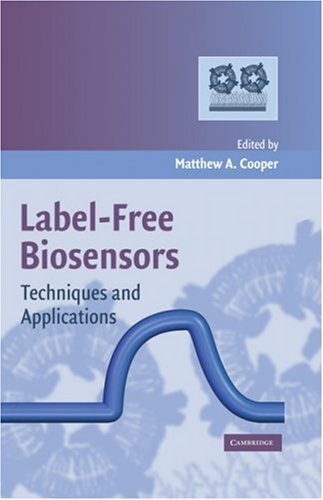Matthew A. Cooper0521884535, 9780521884532, 0521711517, 9780521711517
Table of contents :
Cover……Page 1
Half-title……Page 3
Title……Page 5
Copyright……Page 6
Contents……Page 7
Contributors……Page 9
Preface……Page 11
INTRODUCTION……Page 15
RATIONALE FOR LABEL-FREE DETECTION……Page 17
OPTICAL BIOSENSORS……Page 18
Sensitivity……Page 21
Resolution (or limit of determination)……Page 22
Ease of use……Page 23
Detection instrumentation……Page 24
Throughput……Page 25
Surface plasmon resonance……Page 26
HOLOGRAM BIOSENSORS……Page 28
Reflectometric interference spectroscopy……Page 30
Dual polarization interferometry……Page 32
PHOTONIC CRYSTAL BIOSENSOR……Page 33
WHISPERING GALLERY MODE RESONATORS……Page 36
CONCLUSIONS……Page 39
REFERENCES……Page 41
2 Experimental design……Page 43
ASSAY FORMAT……Page 44
IMMOBILIZATION……Page 46
Ligand activity……Page 47
Regeneration……Page 48
Analysis of regeneration data……Page 49
Reference subtraction……Page 50
Solvent correction……Page 67
BUFFER SCOUTING……Page 68
Wash procedures……Page 69
Positive and negative controls……Page 70
Sample preparation……Page 71
SMALL-MOLECULE SCREENING……Page 72
General principles……Page 74
Systematic errors and blank injections……Page 75
ACKNOWLEDGMENTS……Page 76
REFERENCES……Page 77
INTRODUCTION……Page 78
USING SPR TO OBTAIN AFFINITY CONSTANTS……Page 79
DEFINING AFFINITY CONSTANTS……Page 83
METHODS FOR DETERMINING AFFINITY CONSTANTS USING SPR……Page 84
Generating equilibrium data……Page 85
Data processing……Page 88
Applying a simple binding model……Page 89
Applying complex binding models……Page 92
Indirect affinity determination……Page 97
WORKED EXAMPLES……Page 103
REFERENCES……Page 112
INTRODUCTION……Page 115
USING SPR TO MONITOR BINDING KINETICS……Page 116
Correlating structure with function……Page 117
Interpreting bindingmechanisms……Page 118
Engineering proteins……Page 119
Discovering new drugs……Page 120
OBTAINING KINETIC RATE CONSTANTS……Page 122
Interpreting kinetic data……Page 125
Choosing an interaction model……Page 126
Applying the fitting method……Page 127
Evaluating fitting results……Page 129
Applying complex models……Page 131
APPENDIX: WORKED EXAMPLES……Page 132
REFERENCES……Page 138
5 Sensor surfaces and receptor deposition……Page 140
INTRODUCTION……Page 141
WHAT CHEMISTRY TO USE?……Page 142
When to use thiol coupling……Page 143
When to use aldehyde coupling……Page 144
Covalent coupling chemistry summary……Page 146
Epitope tags……Page 147
NTA-nickel……Page 148
Hydrophobic and amphipathic SAMs……Page 149
Polymer surfaces……Page 150
Dextran……Page 151
Hyaluronic acid……Page 155
Molecularly imprinted polymers……Page 156
Amine coupling……Page 157
Thiol coupling……Page 159
Aldehyde coupling……Page 166
Noncovalent capture……Page 167
Cross-linkage……Page 168
EDC and NHS……Page 169
REFERENCES……Page 170
THE SCOPE OF MACROMOLECULAR INTERACTIONS……Page 173
Multicomponent complexes……Page 174
Multivalency and avidity……Page 175
Cooperativity and conformational change……Page 176
Measuring interaction kinetics……Page 177
Determining specificity……Page 178
Combined structural and functional studies……Page 179
Epitope mapping……Page 180
Ligand fishing……Page 183
PRACTICAL ASPECTS……Page 184
Confirmation of surface activity……Page 185
Choice of regeneration conditions……Page 186
SUMMARY……Page 187
REFERENCES……Page 188
INTRODUCTION……Page 189
SUPPORTED LIPID MONOLAYERS……Page 190
TETHERED BILAYER MEMBRANES……Page 192
POLYMER-SUPPORTED LIPID LAYERS……Page 193
MICROARRAYED LIPID LAYERS……Page 195
G-COUPLED PROTEIN RECEPTORS……Page 196
GPCR interactions monitored with flow-based biosensors……Page 197
GPCR interactions analysis with cell impedancemeasurement……Page 198
KINETIC ANALYSIS OF LIPID BINDING……Page 199
General experimental considerations……Page 201
WORKED EXAMPLES……Page 202
REFERENCES……Page 207
INTRODUCTION……Page 209
Experimental considerations……Page 210
Overview on applications……Page 211
Monoclonal anti-β-amyloid antibodies; screening, characterization, anti-immunogenicity testing……Page 212
Experimental considerations……Page 217
Overview on applications……Page 218
Virtual and SPR screening for HPPK inhibitor……Page 222
Screening for allosteric site binders of a heterotrimeric protein……Page 223
Validation of DPP-IV lead series using high-resolution kinetic analysis and modified binding site controls……Page 227
Mechanistic aspects of inhibition of DHNA……Page 229
SUMMARY……Page 232
REFERENCES……Page 233
INTRODUCTION……Page 236
Corning Epic System: Theory of operation……Page 237
Screening small-molecule/protein interactions……Page 239
Functional enzymatic assays: Detecting the proteolytic cleavage of biomolecules……Page 240
Theory of detection (dynamic mass redistribution)……Page 243
Panning endogenous receptors in a cell system……Page 244
Analyzing systems cell biology of receptor signaling……Page 245
CONCLUSION……Page 246
WORKED EXAMPLES……Page 248
REFERENCES……Page 252
INTRODUCTION……Page 253
Introduction to the ITC experiment……Page 254
Application example – binding thermodynamics of statins to HMG-CoA reductase……Page 258
ITC INSTRUMENT DESIGN……Page 261
Reduction in sample quantity requirements……Page 264
Increases in sample throughput……Page 266
Low-protein quantity data comparison……Page 268
Experiment design alternatives to minimize protein usage……Page 271
Example: Binding study of carbonic anhydrase II tomultiple ligands……Page 273
The ITC experiment design window……Page 274
CONCLUSIONS……Page 278
REFERENCES……Page 279
INTRODUCTION……Page 281
Electrical impedance technology……Page 282
Bioimpedance of cells……Page 283
THE CELLKEY SYSTEM……Page 286
CellKey system specifications……Page 288
WORKED EXAMPLES……Page 290
Preparing cell plates……Page 291
Controls……Page 292
Assay Protocols……Page 294
Executing experiments……Page 295
Data analysis and results……Page 297
Cell lines andmaterials……Page 302
Cell culture……Page 303
REFERENCES……Page 304
Index……Page 309

Reviews
There are no reviews yet.